Fracture of Titanium Alloys at High Strain Rates and under Stress Triaxiality
Abstract
:1. Introduction
2. Experimental Procedure
2.1. Quasistatic and Dynamic Tensile Tests
2.2. Numerical Simulation of Plastic flow and Damage Evolution
- Conservation Equations (5),
- Kinematic relations (6),
- Constitutive relations (7),
- Equation of State (8),
- Relaxation Equation for the deviatoric stress tensor (9).
2.3. Damage Model
3. Results
3.1. Results of Tensile tests
3.2. Strain Fields Observation by Digital Image Correlation (DIC)
3.3. Fracture Surface Observation
3.4. Results of Simulation
4. Summary and Conclusions
- (1)
- Obtained experimental data indicate the dependence of the fracture surface roughness parameter Sa on the stress triaxiality η in the titanium alloy.
- (2)
- Results confirm that the fracture of near alpha titanium alloys has ductile behavior at strain rates from 0.1 to 1000 s−1, stress triaxiality parameter 0.33 < η < 0.6, and temperature close to 295 K. The ductile to brittle transition has not been observed in Ti-5Al-2.5Sn titanium alloy under investigated loading conditions.
- (3)
- The alloy undergoes fracture governing by damage nucleation, growth, and coalescence in the localized plastic strain bands oriented along the maximum shear stresses. In the neck zone, which has formed upon tension of smooth specimens, the orientation angle of cracks and localized shear bands is close to 45° to the tensile axis.
- (4)
- Formation of adiabatic shear bands has not been detected in Ti-5Al-2.5Sn alloy under the studied loading condition. This has been confirmed by a rather high roughness of fracture surfaces. Trajectory of plastic strain localization bands and their intersection in separation zone determines the orientation of separation cracks near the stress concentrator zone.
- (5)
- Results of numerical simulation show that evolution of stresses and stress triaxiality η near shear band intersection zone influence the damage accumulation and formation of the fracture zone trajectory.
Author Contributions
Funding
Acknowledgments
Conflicts of Interest
References
- Frost, H.J.; Ashby, M.F. Deformation-Mechanism Maps; Pergamon Press: Oxford, UK, 1982. [Google Scholar]
- Antunes, R.A.; Salvador, C.A.F.; de Oliveira, M.C.L. Materials selection of optimized titanium alloys for aircraft applications. Mater. Res. 2018, 21, e20170979. [Google Scholar] [CrossRef] [Green Version]
- Peters, M.; Kumpfert, J.; Ward, C.H.; Leyens, C. Titanium Alloys for Aerospace Applications. Adv. Eng. Mater. 2003, 5, 419–427. [Google Scholar] [CrossRef]
- Wei, K.; Zeng, X.; Huang, G.; Deng, J.; Liu, M. Selective laser melting of Ti-5Al-2.5Sn alloy with isotropic tensile properties: The combined effect of densification state, microstructural morphology, and crystallographic orientation characteristics. J. Mater. Proc. Technol. 2019, 271, 368–376. [Google Scholar] [CrossRef]
- Gao, C.Y.; Zhang, L.C.; Yan, H.X. A new constitutive model for HCP metals. Mater. Sci. Eng. A 2011, 528, 4445–4452. [Google Scholar] [CrossRef]
- Xu, Q.; Meyers, M.A.; Nesterenko, V.F. Self-organization of shear bands in titanium and Ti–6Al–4V alloy. Acta Mater. 2002, 50, 575–596. [Google Scholar] [CrossRef]
- Herzig, N.; Meyer, L.W.; Musch, D.; Halle, T.; Skripnyak, V.A.; Skripnyak, E.G.; Razorenov, S.V.; Krüger, L. The Mechanical Behaviour of Ultrafine Grained Titanium Alloys at High Strain Rates. In Proceedings of the 3rd International Conference on High Speed Forming, Dortmund, Germany, 11–12 March 2008; p. 14. [Google Scholar] [CrossRef]
- Skripnyak, V.A.; Skripnyak, E.G. Mechanical Behaviour of Nanostructured and Ultrafine-Grained Metal Alloy under Intensive Dynamic Loading. In Chapter 2: Nanotechnology and Nanomaterials “Nanomechanics”; Vakhrushev, A., Ed.; InTech: Rijeka, Croatia, 2017; ISBN1 978-953-51-3182-3. ISBN2 978-953+-51-3181-6. [Google Scholar] [CrossRef] [Green Version]
- Skripnyak, V.A.; Skripnyak, N.V.; Skripnyak, E.G.; Skripnyak, V.V. Influence of grain size distribution on the mechanical behavior of light alloys in wide range of strain rates. AIP Conf. Proc. 2017, 1793, 110001. [Google Scholar] [CrossRef]
- Skripnyak, N.V.; Skripnyak, E.G.; Skripnyak, V.A.; Skripnyak, V.V.; Vaganova, I.K. Failure Mechanisms of Light Alloys with a Bimodal Grain Size Distribution. In Proceedings of the 11th World Congress on Computational Mechanics, WCCM 2014, 5th European Conference on Computational Mechanics, ECCM 2014 and 6th European Conference on Computational Fluid Dynamics, Barcelona, Spain, 20–25 July 2014. [Google Scholar]
- Sharkeev, Y.P.; Vavilov, V.P.; Belyavskaya, O.A.; Skripnyak, V.A.; Nesteruk, D.A.; Kozulin, A.A.; Kim, V.M. Analyzing deformation and damage of VT1-0 titanium in different structural states by using infrared thermography. J. Nondestruct. Eval. 2016, 35, 42. [Google Scholar] [CrossRef]
- Skripnyak, V.V.; Kozulyn, A.A.; Skripnyak, V.A. The influence of stress triaxiality on ductility of α titanium alloy in a wide range of strain rates. Mater. Phys. Mech. 2019, 42, 415–422. [Google Scholar] [CrossRef]
- Bai, Y.; Wierzbicki, T. A new model of metal plasticity and fracture with pressure and Lode dependence. Int. J. Plast. 2008, 24, 1071–1096. [Google Scholar] [CrossRef]
- Valoppi, B.; Bruschi, S.; Ghiotti, A.; Shivpur, R. Johnson-Cook based criterion incorporating stress triaxiality and deviatoric effect for predicting elevated temperature ductility of titanium alloy sheets. Int. J. Mech. Sci. 2017, 123, 94–105. [Google Scholar] [CrossRef]
- Revil-Baudard, B.; Cazacu, O.; Flater, P.; Chandola, N.; Alves, J.L. Unusual plastic deformation and damage features in titanium: Experimental tests and constitutive modeling. J. Mech. Phys. Solids 2016, 88, 100–122. [Google Scholar] [CrossRef] [Green Version]
- Bobbili, R.; Madhun, V. Flow and fracture characteristics of near alpha titanium alloy. J. Alloys Comput. 2016, 684, 162–170. [Google Scholar] [CrossRef]
- Bai, Y.; Teng, X.; Wierzbicki, T. On the Application of Stress Triaxiality Formula for Plane Strain Fracture Testing. J. Eng. Mater. Technol. 2009, 131, 021002. [Google Scholar] [CrossRef]
- Kondori, B.; Benzerga, A.A.; Needleman, A. Discrete shear-transformation-zone plasticity modeling of notched bars. J. Mech. Phys. Solids 2018, 111, 18–42. [Google Scholar] [CrossRef]
- Zhai, J.; Luo, T.; Gao, X.; Graham, S.M.; Knudsen, E. Modeling the ductile damage process in commercially pure titanium. Int. J. Solids Struct. 2016, 91, 26–45. [Google Scholar] [CrossRef]
- Lindner, D.; Mathieu, F.; Hild, F.; Allix, O.; Minh, C.-H.; Paulien-Camy, O. On the evaluation of stress triaxiality fields in a notched titanium alloy sample via integrated digital image correlation. J. Appl. Mech. 2015, 82, 071014. [Google Scholar] [CrossRef] [Green Version]
- Heibel, S.; Nester, W.; Clausmeyer, T.; Tekkayan, A.E. Failure assessment in sheet metal forming using a phenomenological damage model and fracture criterion: Experiments, parameter identification and validation. Proc. Eng. 2017, 207, 2066–2071. [Google Scholar] [CrossRef]
- Orozco-Caballero, A.; Li, F.; Esqué-de los Ojos, D.; Atkinson, M.D.; Quinta da Fonseca, J. On the ductility of alpha titanium: The effect of temperature and deformation mode. Acta Mater. 2018, 149, 1–10. [Google Scholar] [CrossRef] [Green Version]
- Neilsen, K.L.; Tvergaard, V. Ductile shear failure or plug failure of spot welds modelled by modified Gurson model. Eng. Fract. Mech. 2010, 77, 1031–1047. [Google Scholar] [CrossRef]
- Tvergaard, V. Study of localization in a void-sheet under stress states near pure shear. Int. J. Solids Struct. 2015, 60–61, 28–34. [Google Scholar] [CrossRef]
- Huang, W.; Zan, X.; Nie, X.; Gong, M.; Wang, Y.; Xia, Y.M. Experimental study on the dynamic tensile behavior of a poly-crystal pure titanium at elevated temperatures. Mater. Sci. Eng. A. 2007, 443, 33–41. [Google Scholar] [CrossRef]
- Corigliano, A.; Mariani, S.; Orsatti, B. Identification of Gurson–Tvergaard material model parameters via Kalman filtering technique. I. Theory. Int. J. Fract. 2000, 104, 349–373. [Google Scholar] [CrossRef]
- Mirone, G.; Barbagallo, R.; Corallo, D. A new yield criteria including the effect of lode angle and stress triaxiality. Proc. Struct. Integr. 2016, 2, 3684–3696. [Google Scholar] [CrossRef] [Green Version]
- Shi, X.; Zhao, C.; Cao, Z.; Zhang, T.; Wang, T.; Qiao, J. Mechanical behavior of a near α titanium alloy under dynamic compression: Characterization and modeling. Prog. Nat. Sci. Mater. Int. 2019, 29, 432–439. [Google Scholar] [CrossRef]
- Donachie, M.J., Jr. Titanium A Technical Guide, 2nd ed.; ASM: Materials Park, OH, USA, 2000; ISBN 978-0-87170-686-7. [Google Scholar]
- Bros, H.; Michel, M.-L.; Castanet, R. Enthalpy and heat capacity of titanium based alloys. J. Therm. Anal. 1994, 41, 7–24. [Google Scholar] [CrossRef]
- Zhang, B.; Wang, J.; Wang, Y.; Wang, Y.; Li, Z. Strain-rate-dependent tensile response of Ti–5Al–2.5Sn alloy. Materials 2019, 12, 659. [Google Scholar] [CrossRef] [Green Version]
- Zhang, B.; Wang, J.; Wang, Y.; Li, Z.; Wang, Y. Dynamic strain-rate effect on uniaxial tension deformation of Ti5Al2.5Sn α-titanium alloy at various temperatures. Mater. High Temper. 2019, 36, 1–10. [Google Scholar] [CrossRef]
- Springmann, M.; Kuna, M. Identification of material parameters of the Gurson–Tvergaard–Needleman model by combined experimental and numerical techniques. Comput. Mater. Sci. 2005, 32, 544–552. [Google Scholar] [CrossRef]
- Wang, Y.L.; Hui, S.X.; Liu, R.; Ye, W.J.; Yu, Y.; Kayumov, R. Dynamic response and plastic deformation behavior of Ti-5Al-2.5Sn ELI and Ti-8Al −1Mo −1V alloys under high-strain rate. Rare Met. 2014, 33, 127–133. [Google Scholar] [CrossRef]
- Osovski, S.; Srivastava, A.; Ponson, L.; Bouchaud, E.; Tvergaard, V.; Ravi-Chandar, K.; Needleman, A. The effect of loading rate on ductile fracture toughness and fracture surface roughness. J. Mech. Phys. Solids 2015, 76, 20–46. [Google Scholar] [CrossRef]
- Ponson, L.; Caom, Y.; Bouchaud, E.; Tvergaard, V.; Needleman, A. Statistics of ductile fracture surfaces: The effect of material parameters. Int. J. Fract. 2013, 184, 137–149. [Google Scholar] [CrossRef]
- Needleman, A.; Tvergaard, V.; Bouchaud, E. Prediction of Ductile Fracture Surface Roughness Scaling. J. Appl. Mech. 2012, 79, 031015. [Google Scholar] [CrossRef]
- Chang, Q.; Chen, D.L.; Ru, H.Q.; Yue, X.Y.; Yu, L.; Zhang, C.P. Three-dimensional fractal analysis of fracture surfaces in titanium–iron particulate reinforced hydroxyapatite composites: Relationship between fracture toughness and fractal dimension. J. Mater. Sci. 2011, 46, 6118–6123. [Google Scholar] [CrossRef]
- Mandelbrot, B.; Passoja, D.; Paulay, A.J. Fractal character of fracture surfaces of metals. Nature 1984, 308, 721–722. [Google Scholar] [CrossRef]
- Liang, H.; Pan, F.S.; Chen, Y.M.; Yang, J.J.; Wang, J.F.; Liu, B. Influence of the Strain Rates on Tensile Properties and Fracture Interfaces for Mg-Al Alloys Containing, Y. Adv. Mater. Res. 2011, 284, 1671–1677. [Google Scholar] [CrossRef]
- Azinfar, M.J.; Ghazvinian, A.H.; Nejati, H.R. Assessment of scale effect on 3D roughness parameters of fracture surfaces. Eur. J. Env. Civ. Eng. 2016, 23, 1–28. [Google Scholar] [CrossRef]
- Carney, L.R.; Mecholsky, J.J., Jr. Relationship between fracture toughness and fracture surface fractal dimension in AISI 4340 steel. Mater. Sci. Appl. 2013, 4, 258–267. [Google Scholar] [CrossRef] [Green Version]
- Armstrong, R.W.; Zerilli, F.J. Dislocation mechanics aspects of plastic instability and shear banding. Mech. Mater. 1994, 17, 319–327. [Google Scholar] [CrossRef]
- Alonso, U.; Veiga, F.; Suárez, A.; Artaza, T. Experimental Investigation of the Influence of Wire Arc Additive Manufacturing on the Machinability of Titanium Parts. Metals 2020, 10, 24. [Google Scholar] [CrossRef] [Green Version]
- Pantazopoulos, G.A. A short review on fracture mechanisms of mechanical components operated under industrial process conditions: Fractographic analysis and selected prevention strategies. Metals 2019, 9, 148. [Google Scholar] [CrossRef] [Green Version]
- Döner, M.; Conrad, H. Deformation mechanisms in commercial Ti-5Al-2.5Sn (0.5 At. pct Oeq) alloy at intermediate and high temperatures (0.3–0.6 Tm). Metall. Trans. A 1975, 6, 853–861. [Google Scholar] [CrossRef]
- Chichili, D.R.; Ramesh, K.T.; Hemker, K.J. The high-strain rate response of alpha-titanium: Experiments, deformation mechanisms and modeling. Acta Mater. 1998, 46, 1025–1043. [Google Scholar] [CrossRef]
- Roth, A.; Amouzou, K.E.K.; Lebyodkin, M.A.; Richeton, T.; Lebedkina, T.A.; Lecomte, J.S. Three-Stage Character of Strain Hardening of α-Ti in Tension Conditions. Mater. Sci. Forum 2014, 783–786, 568–573. [Google Scholar] [CrossRef]
- Salem, A.A.; Kalidindi, S.R.; Doherty, R.D. Strain hardening of titanium: Role of deformation twinning. Acta Mater. 2003, 51, 4225–4237. [Google Scholar] [CrossRef]
- Li, H.; Mason, D.E.; Yang, Y.; Bieler, T.R.; Crimp, M.A.; Boehlert, C.J. Comparison of the deformation behaviour of commercially pure titanium and Ti-5Al-2.5Sn(wt.%) at 296 and 728K. Philos. Mag. 2013, 93, 2875–2895. [Google Scholar] [CrossRef]
- Bobbili, R.; Madhu, V. Effect of strain rate and stress triaxiality on tensile behavior of Titanium alloy Ti-10-2-3 at elevated temperatures. Mater. Sci. Eng. A 2016, 14, 33–41. [Google Scholar] [CrossRef]
- Verleysen, P.; Peirs, J. Quasi-static and high strain rate fracture behaviour of Ti6Al4V. Int. J. Impact Eng. 2017, 108, 370–388. [Google Scholar] [CrossRef]
- Rodriguez-Millan, M.; Garcia-Gonzalez, D.; Rusinek, A.; Arias, A. Influence of stress state on the mechanical impact and deformation behaviors of aluminum alloys. Metals 2018, 8, 520. [Google Scholar] [CrossRef] [Green Version]
- Zheng, G.; Tang, B.; Zhou, Q.; Mao, X.; Dang, R. Development of a Flow Localization Band and Texture in a Forged Near-α Titanium Alloy. Metals 2020, 10, 121. [Google Scholar] [CrossRef] [Green Version]
- Blaber, J.; Adair, B.; Antoniou, A. Ncorr: Open-Source 2D Digital Image Correlation Matlab Software. Exp. Mech. 2015, 55, 1105–1122. [Google Scholar] [CrossRef]

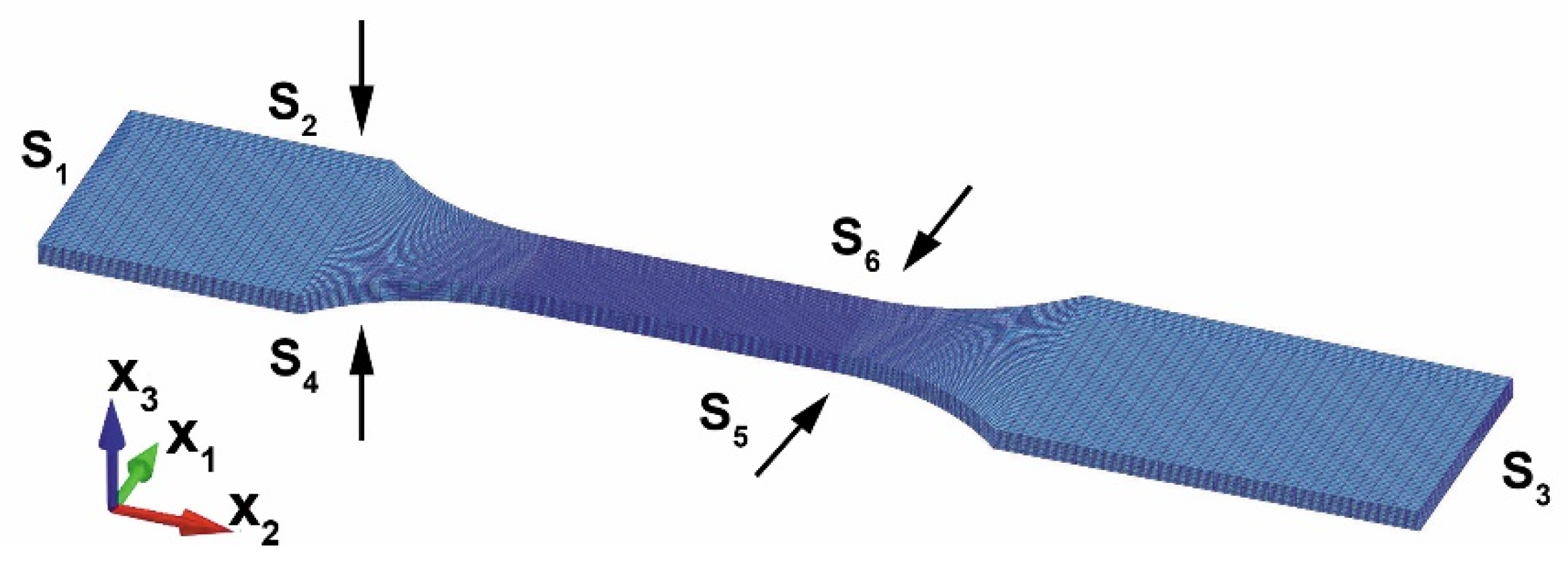

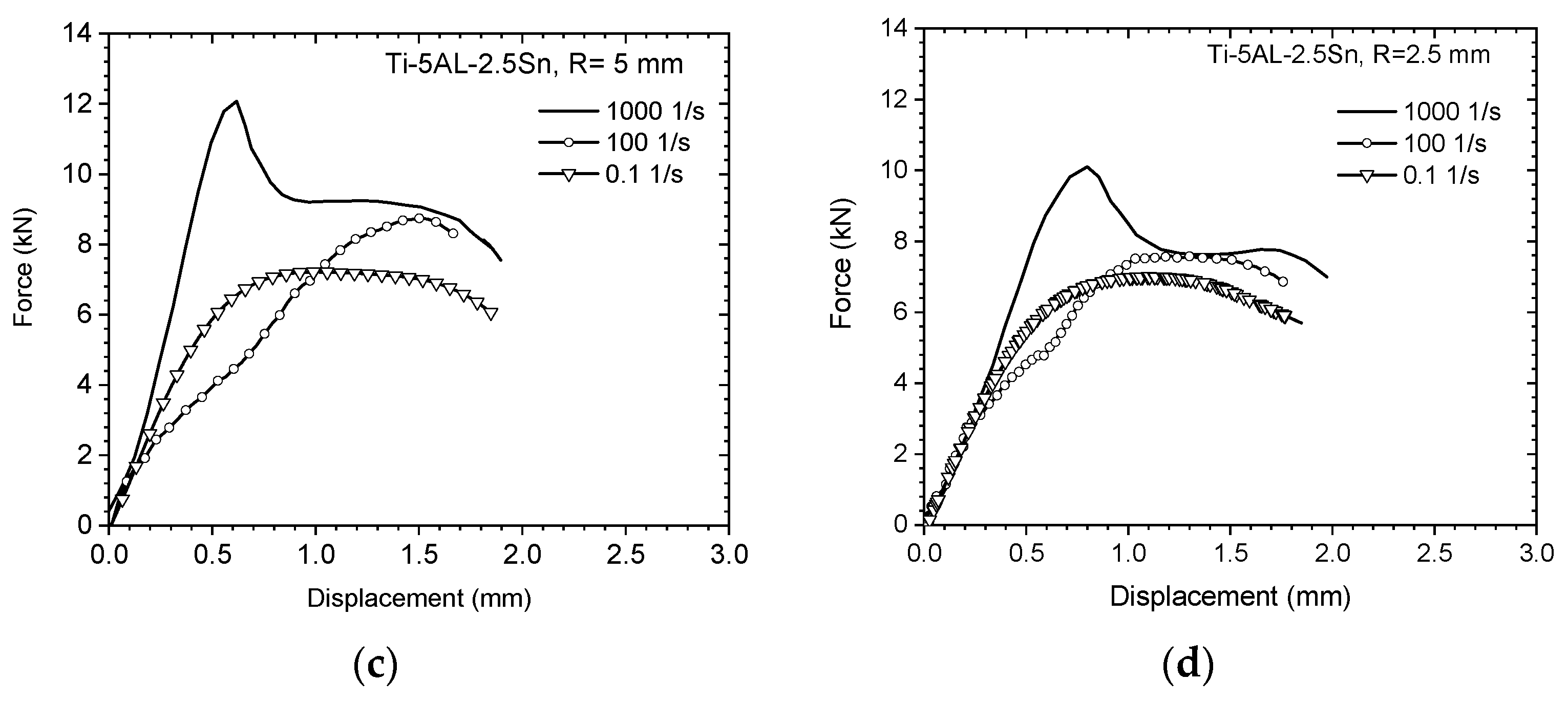



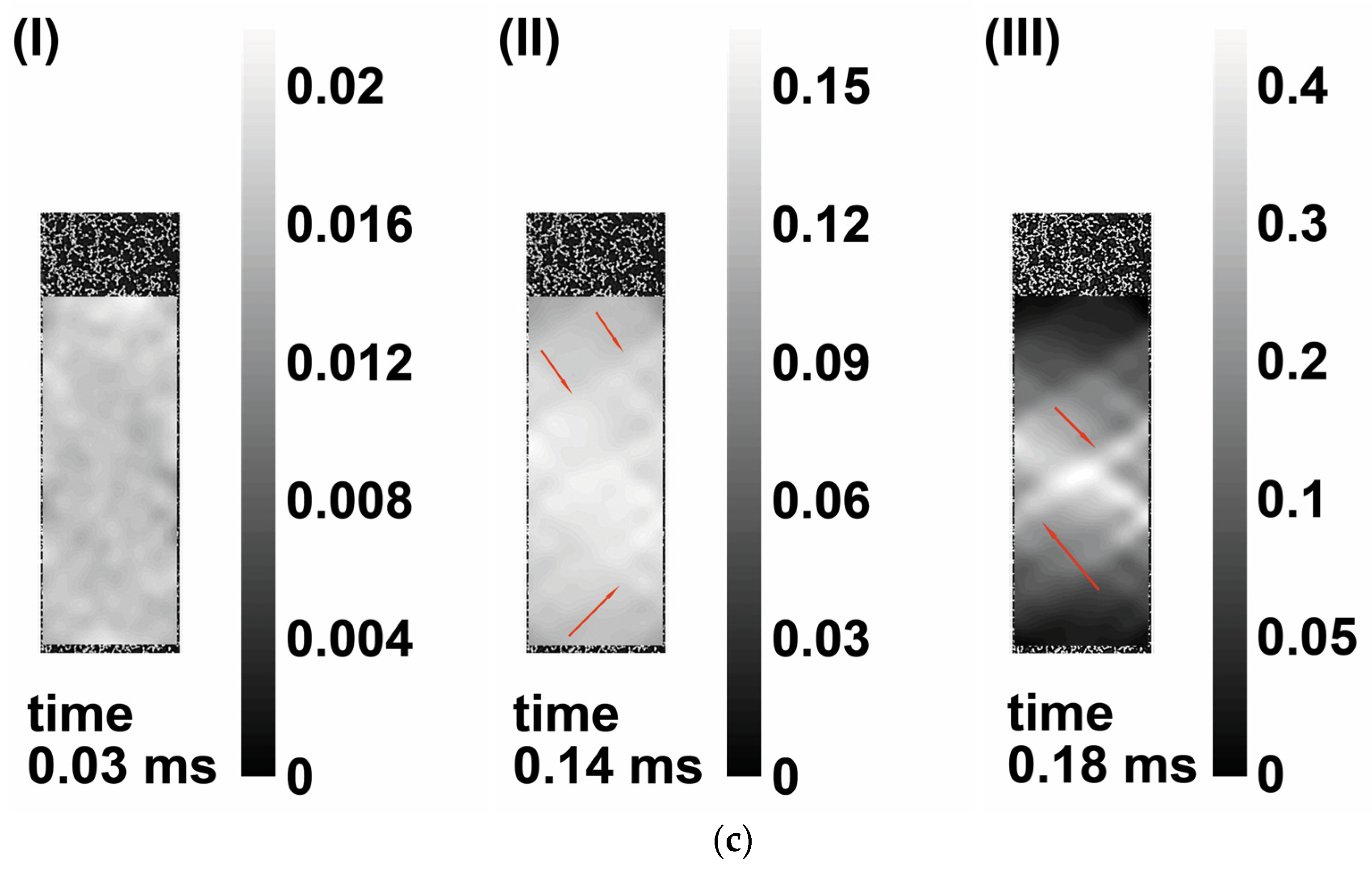
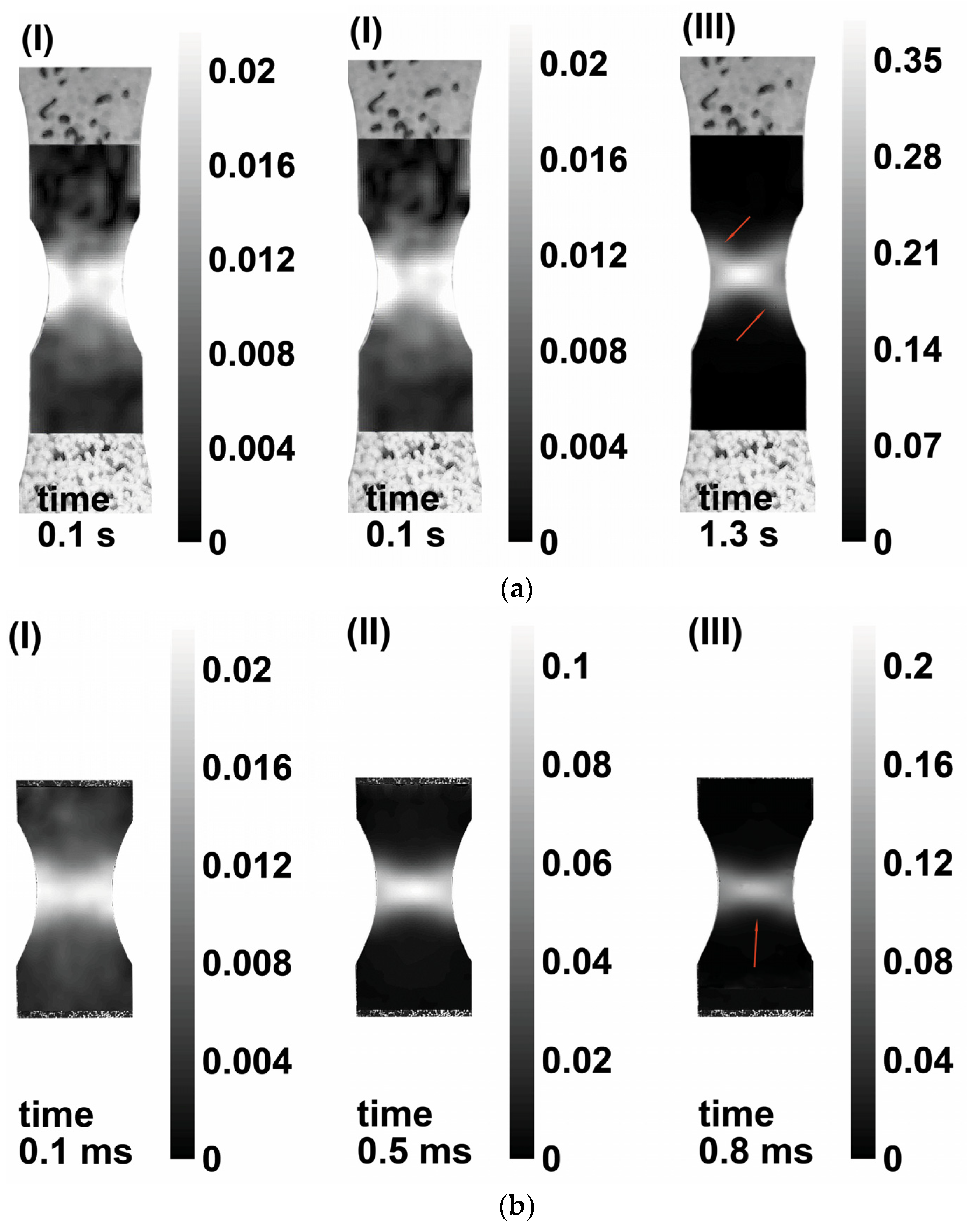
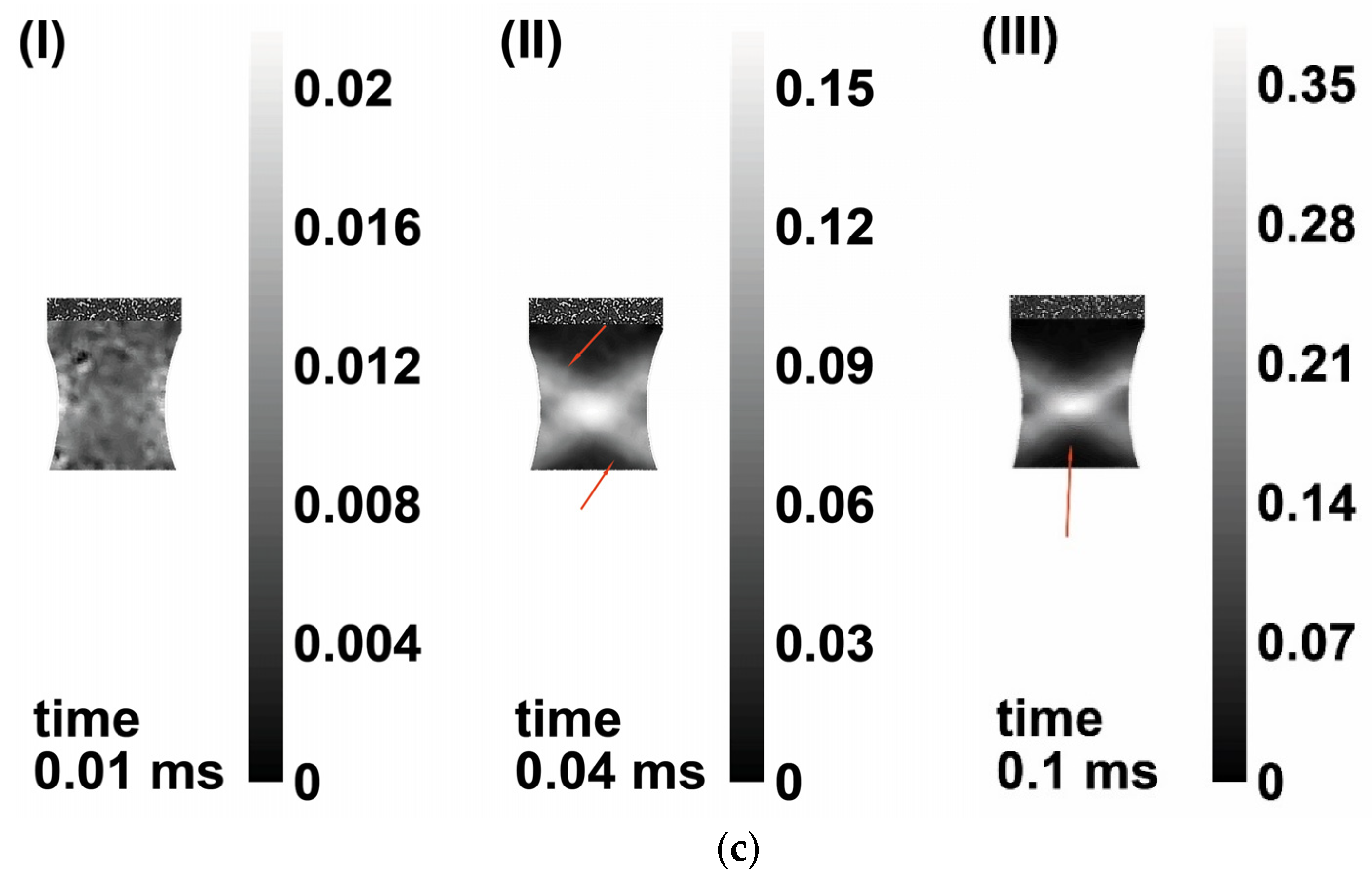

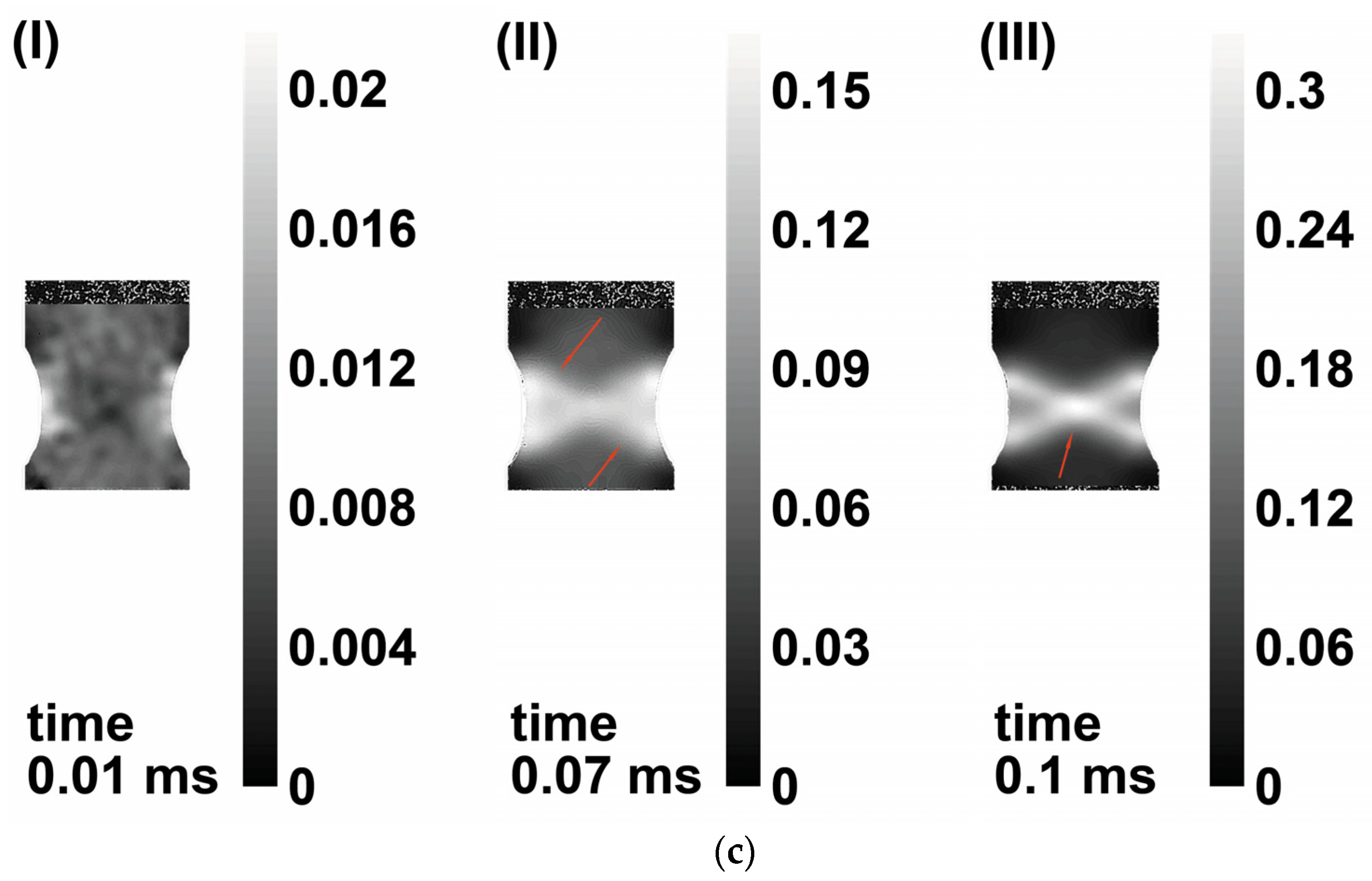

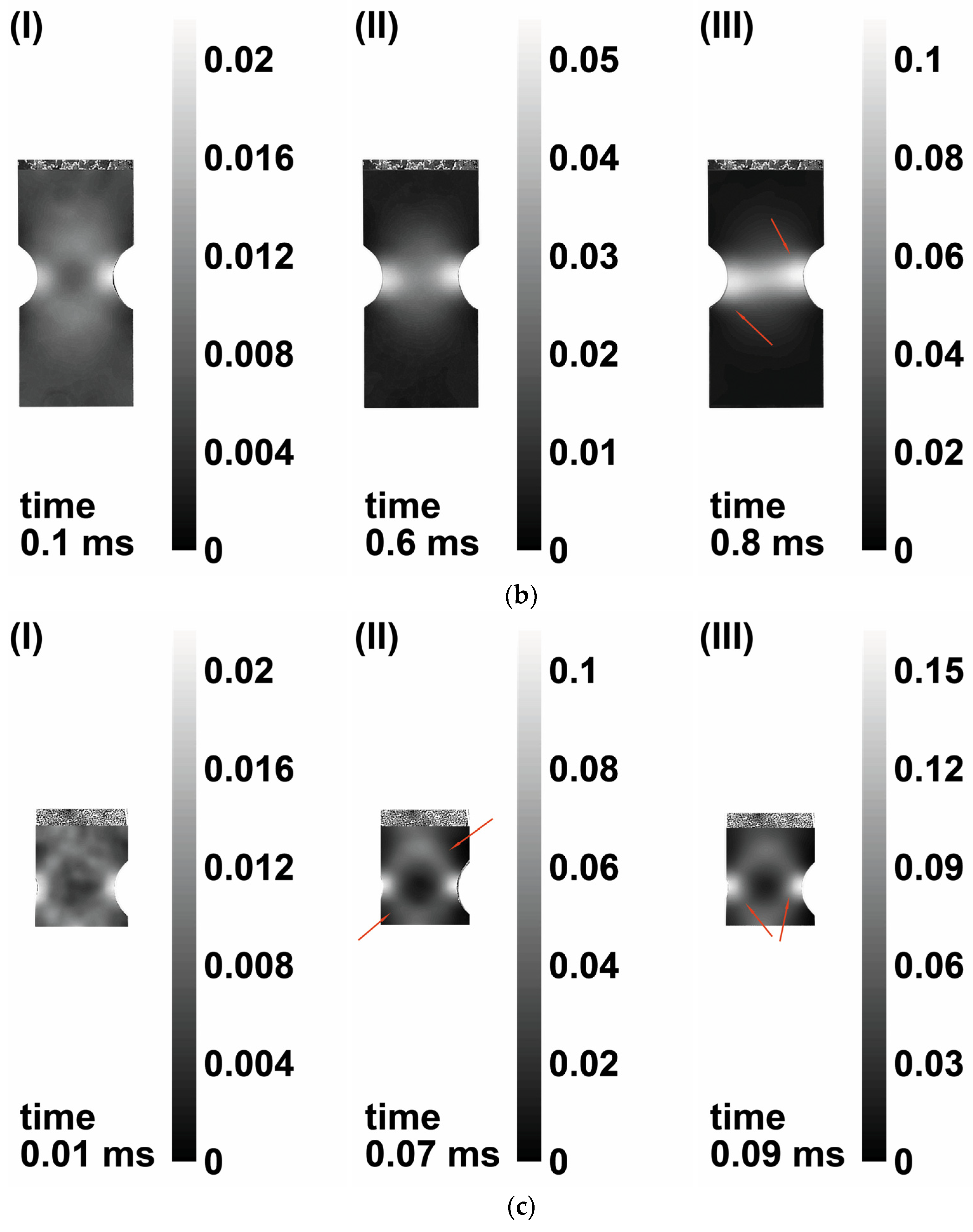
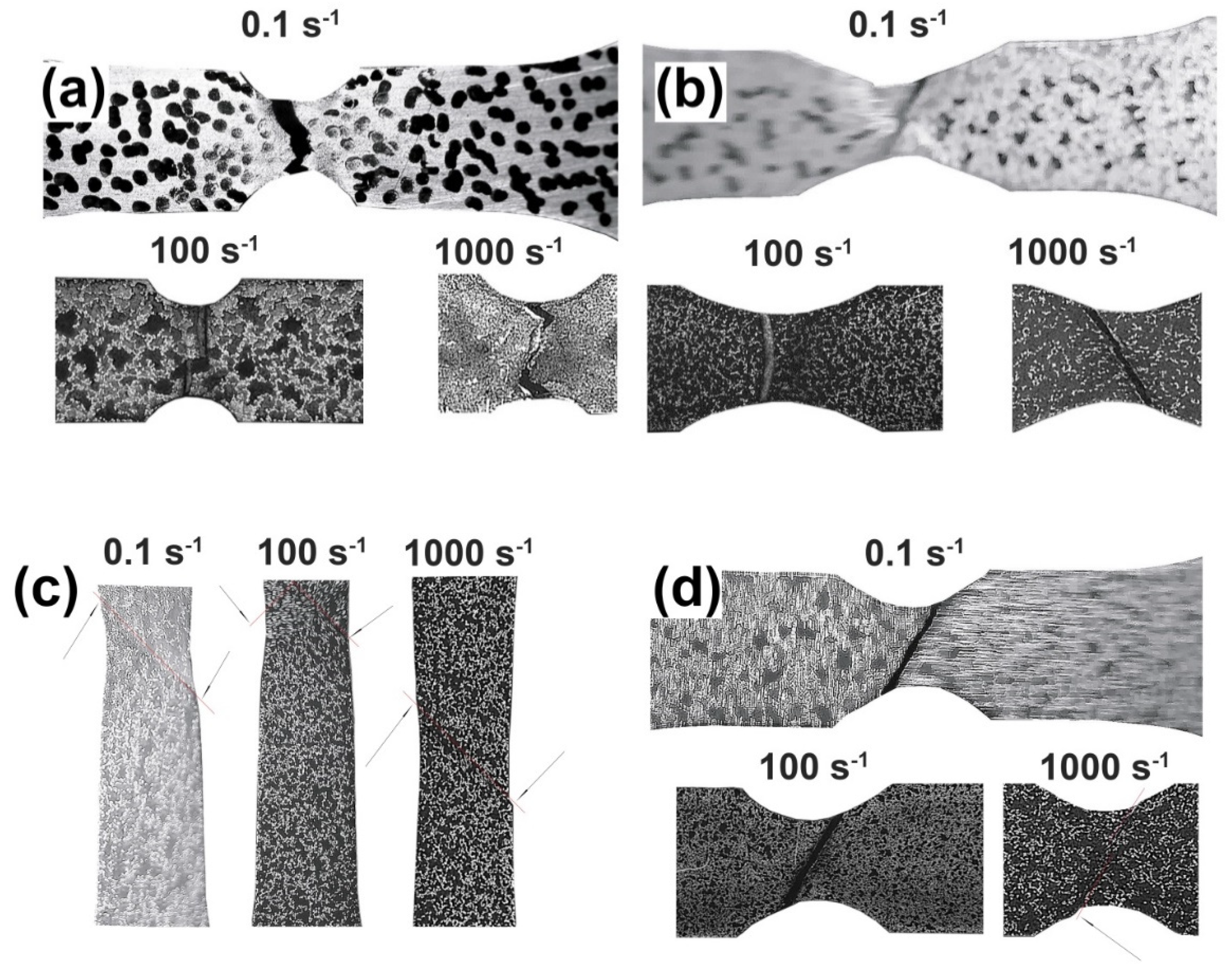

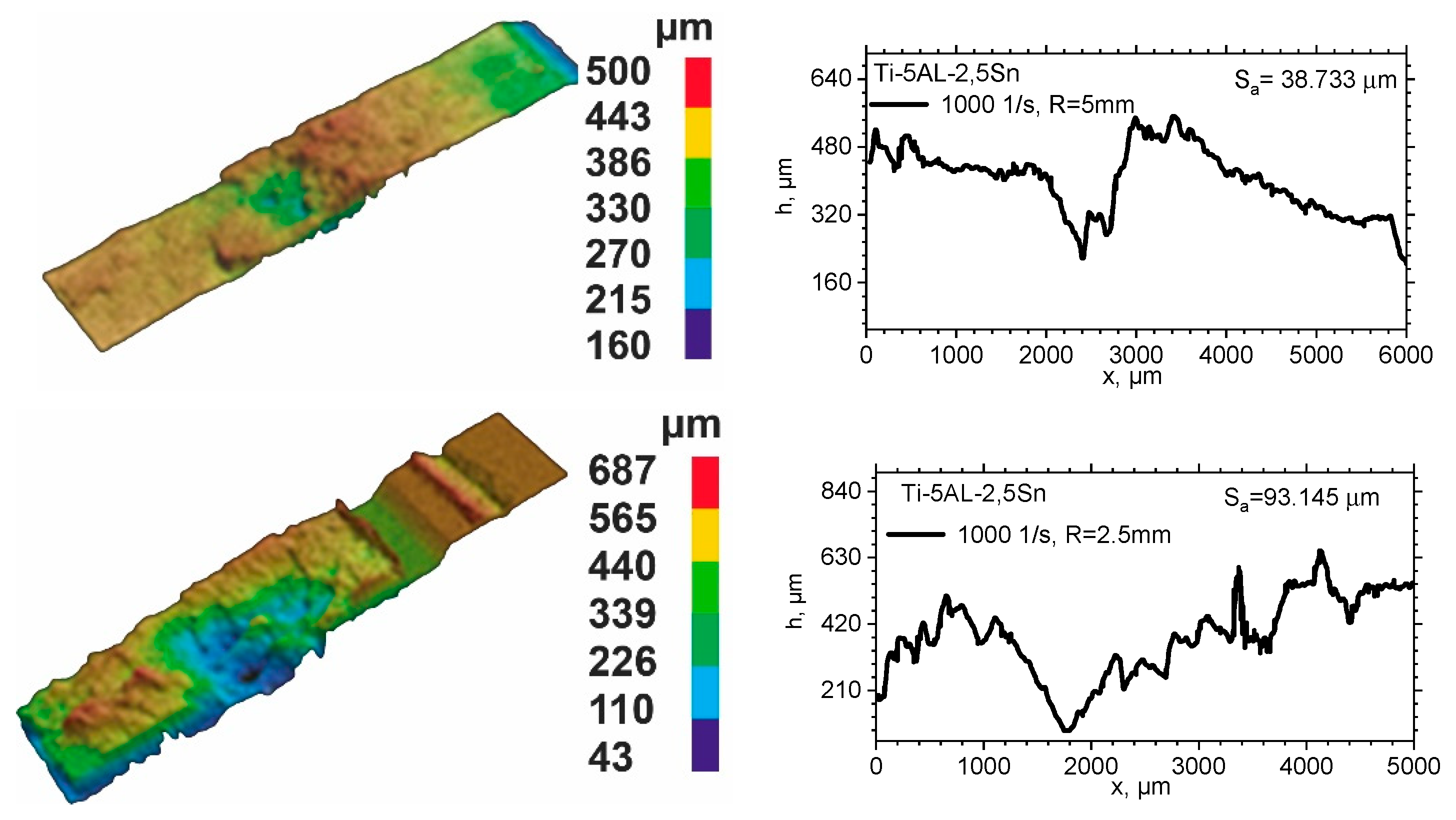
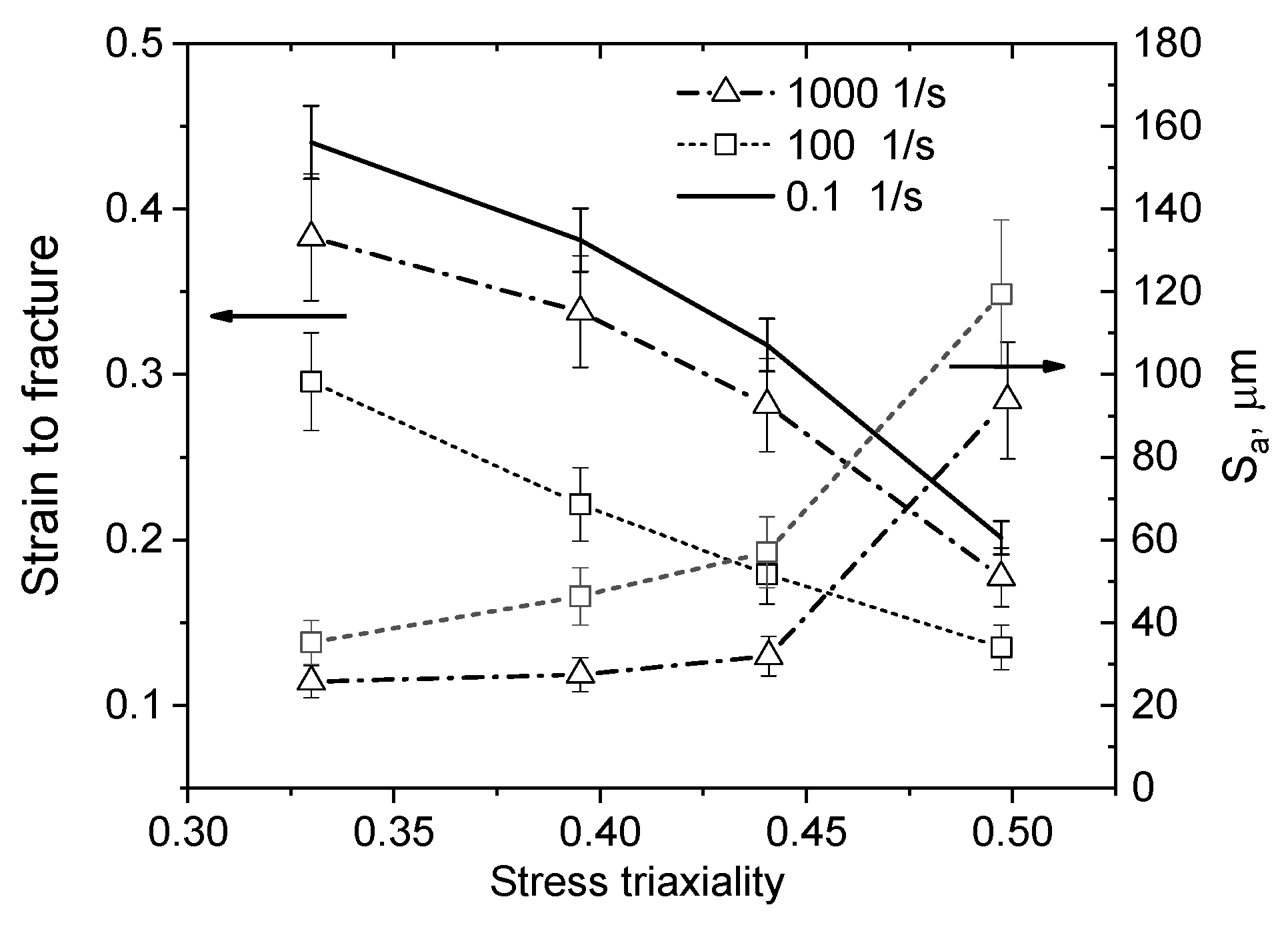
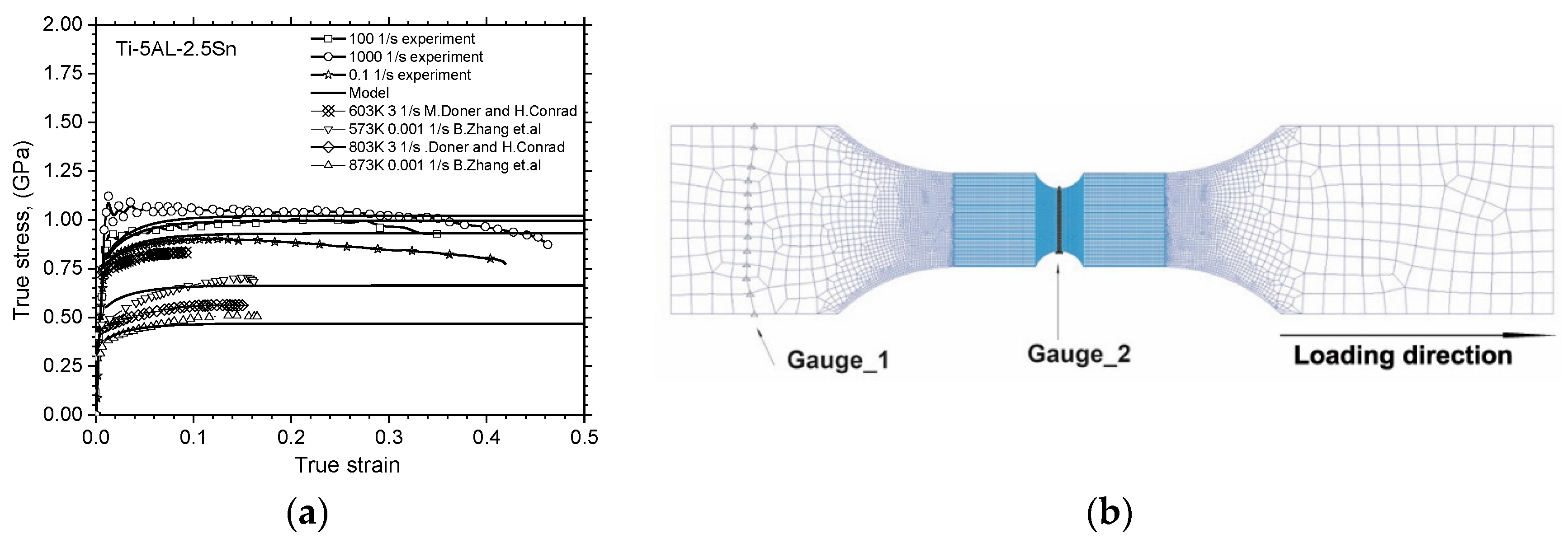


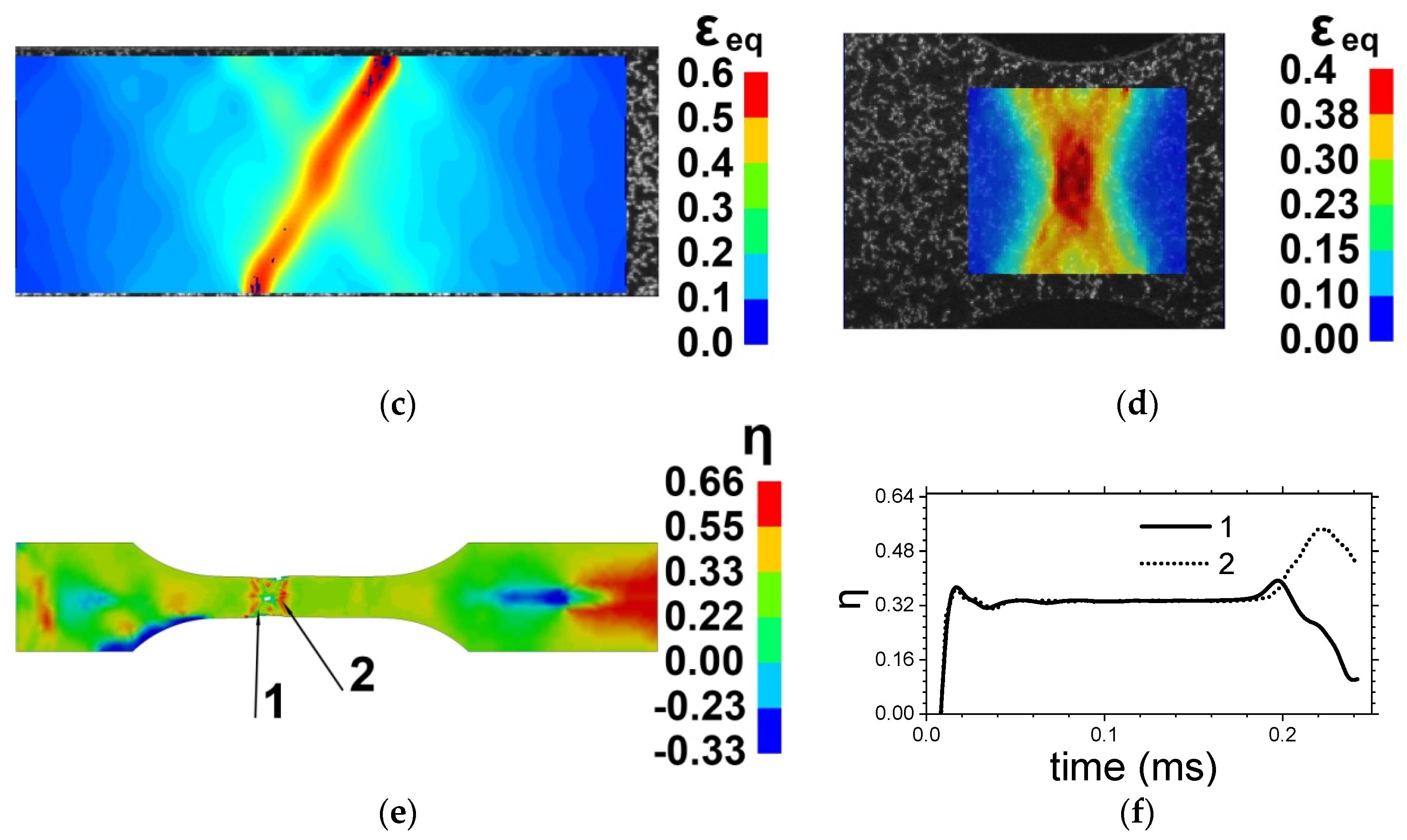

| Coefficients | C1 | C2, GPa | C3, K−1 | C4, K−1 | k0 | Tm, K | |
|---|---|---|---|---|---|---|---|
| Ti-5Al-2.5Sn (Grade 6) | 0.02 | 3.85 | 0.56 | 0.0016 | 0.00009 | 8.5 | 1875 |
| Parameters Equations (8),(9) | q1 | q2 | q3 | f0 | fN | fc | fF | εN | sN |
|---|---|---|---|---|---|---|---|---|---|
| Ti-5Al-2.5Sn (Grade 6) | 1.3 | 1 | 1.69 | 0.00 | 0.2 | 0.035 | 0.4 | 0.28 | 0.1 |
© 2020 by the authors. Licensee MDPI, Basel, Switzerland. This article is an open access article distributed under the terms and conditions of the Creative Commons Attribution (CC BY) license (http://creativecommons.org/licenses/by/4.0/).
Share and Cite
Skripnyak, V.V.; Skripnyak, E.G.; Skripnyak, V.A. Fracture of Titanium Alloys at High Strain Rates and under Stress Triaxiality. Metals 2020, 10, 305. https://doi.org/10.3390/met10030305
Skripnyak VV, Skripnyak EG, Skripnyak VA. Fracture of Titanium Alloys at High Strain Rates and under Stress Triaxiality. Metals. 2020; 10(3):305. https://doi.org/10.3390/met10030305
Chicago/Turabian StyleSkripnyak, Vladimir V., Evgeniya G. Skripnyak, and Vladimir A. Skripnyak. 2020. "Fracture of Titanium Alloys at High Strain Rates and under Stress Triaxiality" Metals 10, no. 3: 305. https://doi.org/10.3390/met10030305




